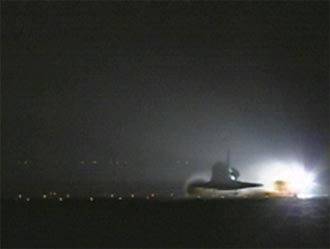| SPACE TODAY ONLINE COVERING SPACE FROM EARTH TO THE EDGE OF THE UNIVERSE | ||||||||||
| COVER | SOLAR SYSTEM | DEEP SPACE | SHUTTLES | STATIONS | ASTRONAUTS | SATELLITES | ROCKETS | HISTORY | GLOBAL LINKS | SEARCH |
Recovering years after the tragedy...
The American Shuttle Fleet Returns
Flight details: 2003 flight » 2005 flight » 2006 flights » 2007 flights »
The U.S. space shuttle Columbia broke up 203,000 feet over north central Texas on February 1, 2003, as it descended from orbit into the atmosphere toward a landing at Kennedy Space Center in Florida. Seven astronauts aboard the shuttle were lost in the disaster. Learn more about the 2003 tragedy »
2005:
STS-114. Discovery lifted America's hopes and dreams to space again on July 26, 2005, in the first shuttle flight since the loss of Columbia in 2003.
Discovery flight STS-114 took off on time on July 26 from launch pad LC-39B at Kennedy Space Center, Florida. It was the 114th space shuttle flight, the 31st flight for shuttle Discovery and the 17th shuttle flight to the International Space Station. It was the 145th U.S. human space flight.
Unfortunately, NASA was forced to ground the shuttle fleet the next day because two large pieces of insulating foam had fallen away from Discovery's external fuel tank during lift-off from Kennedy Space Center. Discovery continued its mission in space and landed on August 9.
A review of videotapes after the launch showed powerful blast-off vibrations had ripped at least two and possibly four pieces of foam insulation from the external fuel tank. The largest piece was estimated to be 24 to 33 inches long, 10 to 14 inches wide, and from 2.5 to 8 inches thick. That's slightly smaller than the chunk of foam that damaged Columbia's wing. Learn more about the 2005 return to space »
2006:
STS-121. A year after its previous flight, Discovery returned America to space when flight STS-121 took off from Kennedy Space Center, Florida, bound for the International Space Station on July 4, 2006.
During their flight and visit at the space station, the astronauts continued the testing of equipment and procedures designed to increase the safety of space shuttles during missions to the space station. Discovery returned to Earth on July 17, 2006.
After the Discovery flight, NASA scheduled more shuttle trips to space in 2006-2007.
STS-115. NASA launched shuttle Atlantis on flight STS-115 on September 9, 2006, to deliver additional truss segments to the space station. It was the second shuttle flight of 2006, the third since the Columbia disaster in 2003, the 116th shuttle flight, and the 19th shuttle flight to the space station. Atlantis had not flown since October 2002.
The Atlantis crew delivered and installed the so-called P3/P4 truss, which is a port-side girder with solar arrays that doubled the International Space Station's power capability.
STS-116. Discovery lit up the night sky as flight STS-116 took off for the international space station on December 10, 2006, UTC. It was the first nighttime shuttle launch in four years. It also was the third shuttle flight of 2006, the fourth since the Columbia disaster in 2003, the 33rd flight for shuttle Discovery, the 117th shuttle flight, and the 20th shuttle flight to the space station.
During their 12-day trip, the crew members are continuing construction of the orbiting laboratory by adding a two-ton segment to its massive integrated truss structure and rewiring the ISS.
NASA scheduled more shuttle trips to space in 2007. Learn more about the 2006 return to space flights »
Learn more: STS-114 STS-121 STS-115 STS-116 STS-117 STS-118 The Tragedy of Space Shuttle Columbia (STO) » Space Shuttle Milestones (CNN) » Shuttle recovery flights: Index 2003 » 2005 » 2006 » NASA space shuttle main page » NASA space station main page »
| Top of this page | Space Shuttles | Search STO | STO Cover | Questions | Feedback |
© 2007 Space Today Online

